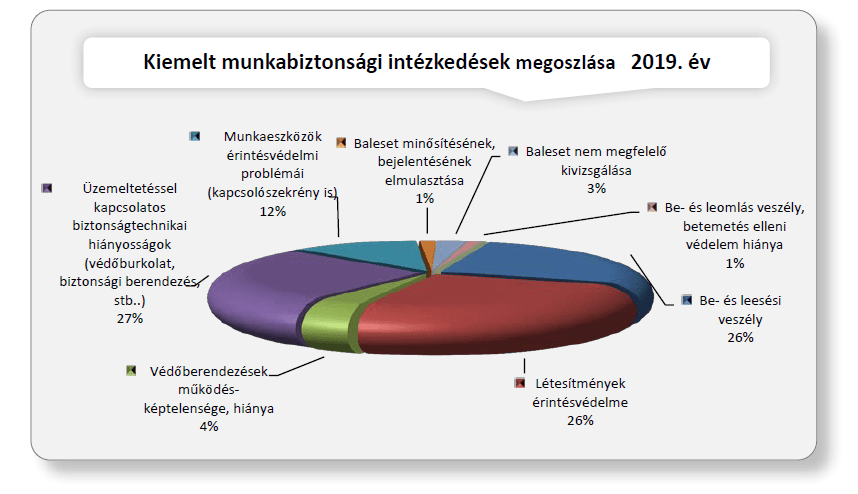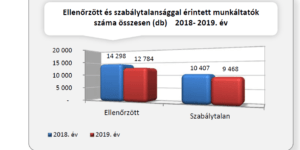The Occupational Safety and Health Department of the Ministry of Innovation and Technology issued its report on the experience of the 2019 inspections in March of this year.
The occupational health and safety authority carried out its inspection activities taking into account the 2019 Inspection Guidelines, the National Authority Inspection Plan and the provisions of its own work plan.
In 2019, the occupational health and safety official inspection work covered 12,784 employers, during which the government officials checked compliance with the rules for safe and non-hazardous work.
The figure below shows the number of inspected employers and those affected by irregularities compared to the 2018 data:

Government officials during inspections The working conditions of 188,337 employees were examined. The examined employers during this period were typically smaller enterprises. Irregularities were found in 66.41 TP3T (125,058 people) of the inspected employees.
Workers employed in irregular conditions His 29.1% was a serious irregularitygal affected.
As a result of the checks, total 18,078 occupational health and safety decisions born. Immediate action was taken in 8,189 orders in connection with situations involving a direct risk of accidents, and in addition, 9,265 decisions requiring the elimination of deficiencies were prepared.
2019 during the sanctioning process In 448 cases, occupational health and safety, administrative fines in 157 cases, In 119 cases, procedural fines were applied the government officials.
Labor protection fine of HUF 197,498,670, administrative fine of HUF 4,784,000 and procedural fine in the amount of HUF 1,330,000 were imposed..
3.5 % of substantive occupational health and safety decisions resulted in monetary sanctions.
One of the indicators of the effectiveness of occupational health and safety official measures is the rate at which employers implement their decisions. In 2019, during their 1,227 visits for follow-up inspections, the labor protection authorities inspected a total of 912 employers, which affected 7.11 TP3T of the inspected employers.
According to the experience of post-inspections, the occupational health and safety official measures are Only 19 employers out of 912 did not implement it.
Amount of procedural fines imposed due to non-implementation of measures In 2019, it was HUF 1,330,000.
The table below contains the most common occupational health and safety violations:

Priority occupational health and safety measures

In total, most measures were taken in 26.5%-aa related to activities with hazardous substances (including hazardous mixtures). The second most common 15,1% deficiency is a "Lack of occupational health and safety knowledge" volt. This was followed by 13.9% of missing medical examinations for occupational fitness. 11% of the deficiencies is related to personal protective equipment and 10% is related to lifting machines.
Measures taken due to deficiencies related to risk assessment account for 7.6% of all measures.
Priority work safety measures

In the course of 2019, government officials had to take measures most often due to electrical safety deficiencies 37.2% among the priority occupational safety measures. Several measures were taken due to the use of inappropriate work tools 31,3%. The proportion of measures taken due to inadequate investigation of work accidents or failure to report them was 4.2%.

Most common shortcoming a "Lack of documented examination of working conditions and the harmful effects of work on health" It was 24.8%. Because the employers did not ask the occupational health service to conduct the occupational health inspection. The occupational health inspection a to be carried out by occupational health services, the assessment of the situation for the evaluation and treatment (reduction) of health-damaging risks, as a result of which the introduction, modification or improvement of the effectiveness of preventive measures can be initiated. Depending on the on-site findings, it may be supplemented as necessary with instrumental tests aimed at measuring exposure related to workplace pathological factors (e.g. noise, vibration exposure, workplace air pollutants, heat exposure).
Government officials still encountered an employer who did not provide occupational health care for its employees.
THE biological pathological factors measures taken in relation to it account for a total of 13.71 TP3T of all prioritized occupational health measures. Particular attention should be paid to the detection of irregularities related to biological pathogenic factors, given that in recent years, health damage caused by microorganisms (viruses, bacteria, fungi, parasites, etc.) accounted for a significant proportion of annual reported, investigated and accepted (registered) occupational diseases . In connection with the effects of climate change, the so-called the risk of infectious diseases (zoonoses) spread by vectors (animal mediators, e.g. insects, rodents) may also increase.
A number of measures have been taken a with occupational carcinogens 18.1% also in connection.
It often takes 10-50 years for a clinically detectable cancer to appear, so both the employer and the employee tend to underestimate the danger of activities with such substances and the importance of complying with the law. The maintenance of the exposure register for workers who work with carcinogens can play a key role in reconstructing cancer cases that may occur later.
In need of special protection vulnerable groups of workers (young people, pregnant women, women who have recently given birth, lactating women and nursing mothers, elderly people, people with altered working capacity) the obligations made during the examination of the employment conditions amount to 7.8% of all priority substantive occupational health measures.
Serious violations
In 2019, the serious violations it was typical that in the case of civil engineering and utility construction earthworks, in many cases, the digging of working pits and working trenches was not completed.
In the construction industry, when working at height a lack of adequate collective technical protection against falling, failure to provide personal protective equipment for protection against falling by the employer, or failure to use it by the employee.
THE in the absence of machine operator authorization (due to inadequate qualifications) most often arose in connection with material handling and storage (unauthorized use of forklifts and forklifts).
Machines and equipment used in the processing industry, machine industry, and agriculture often caused serious accidents lack of protective covers and safety devices for demarcating dangerous areas, or due to the elimination or failure to use them.
For electrical equipment lack of protection against direct or indirect contact was the most common threat. Inadequate fastening of the protective covers of electrical equipment and failure to protect electrical wires against mechanical impact occurred in many work areas.
Among the serious threats to occupational health, the failure to undergo preliminary and periodic occupational medical suitability examinations took a leading place. In the case of the lack of provision of personal protective equipment providing adequate protection for working with hazardous substances/mixtures, or in the case of activities performed in noise exposure exceeding the upper intervention limit, hearing protection equipment was not provided or was not used.
Source: ommf.gov.hu





